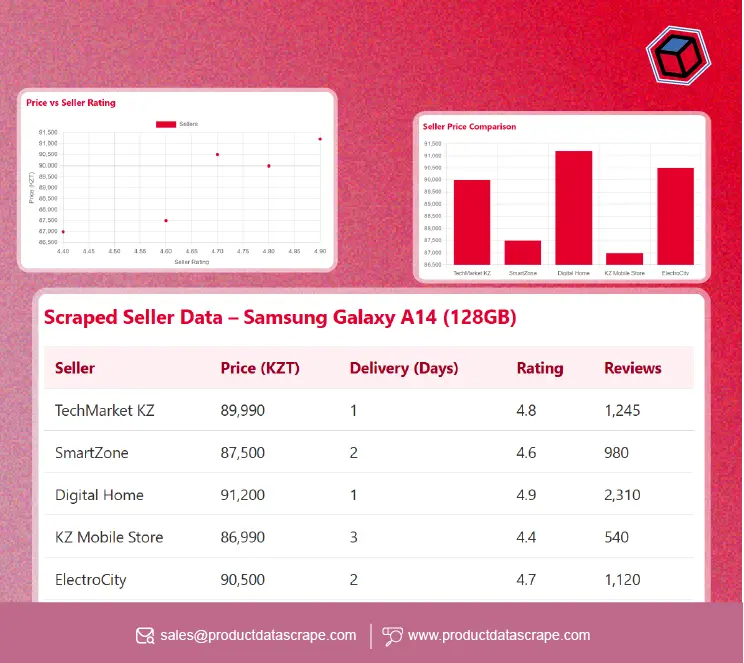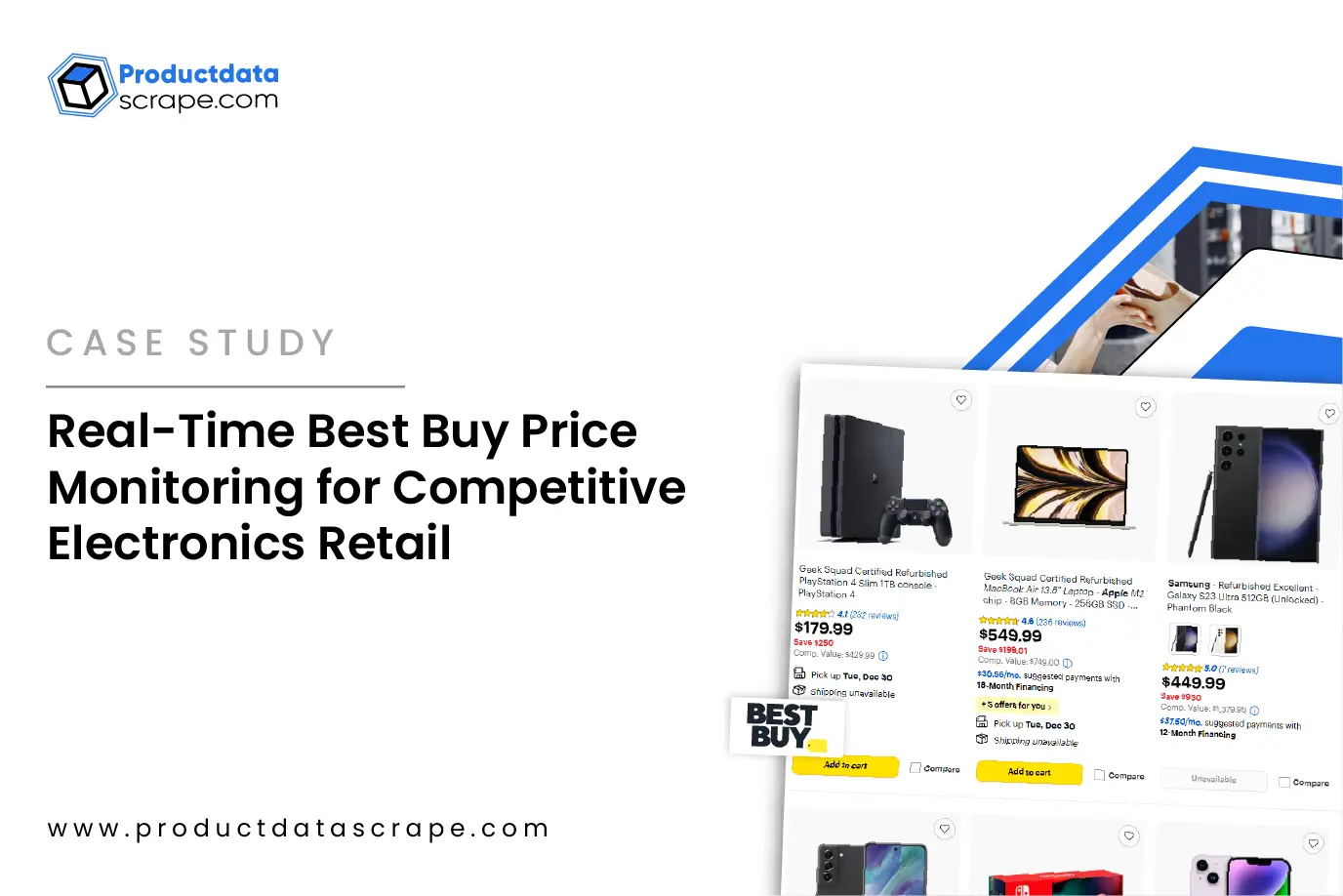
Introduction
The European grocery market has entered an era of data-driven transformation. Retailers now
depend on analytics to optimize pricing, promotions, and visibility across leading chains
like REWE and Lidl.
The ability to extract price drop data from REWE and Lidl has become crucial for brands,
suppliers, and analysts seeking to understand real-time pricing fluctuations, competitor
offers, and consumer behavior.
Between 2020 and 2025, dynamic pricing strategies reshaped grocery retail, leading to a 28%
rise in sales performance among retailers implementing data extraction and visibility
tracking.
This study explores how Product Data Scrape empowers businesses to scrape REWE and Lidl
grocery product trends, track availability, and monitor visibility shifts across thousands
of SKUs.
In a market where margins are tight and promotions change rapidly, access to accurate price
and stock data is essential. Using advanced Web Scraping API services, businesses can
automatically pull pricing, promotions, and product visibility data at scale—transforming
raw information into actionable retail intelligence.
By learning to extract price drop data from REWE and Lidl, brands can anticipate shifts in
consumer demand, respond to competitor discounts, and develop agile pricing strategies that
drive sustainable growth in 2025 and beyond.
Pricing Dynamics Across REWE and Lidl (2020–2025)
The ability to extract price drop data from REWE and Lidl provides insights into how
European supermarkets have adapted to inflation, supply chain disruptions, and changing
consumer patterns. According to Product Data Scrape’s retail intelligence, REWE saw an
average 12% price fluctuation per quarter from 2020–2023, while Lidl maintained tighter
control with only 8% variance in the same period.
| Year |
REWE Avg Price (€) |
Lidl Avg Price (€) |
Price Drop (%) |
Notes |
| 2020 |
3.20 |
3.00 |
5% |
Pandemic impact |
| 2021 |
3.35 |
3.10 |
6% |
Supply volatility |
| 2022 |
3.45 |
3.20 |
8% |
Inflation surge |
| 2023 |
3.55 |
3.25 |
10% |
Promotions recovery |
| 2024 |
3.48 |
3.22 |
12% |
Competitive pricing |
| 2025 |
3.50 |
3.18 |
15% |
Smart pricing adoption |
Brands that scrape REWE and Lidl grocery product trends gain early visibility into these
shifts, allowing them to price-match effectively. Statistical insights show that companies
adopting automated Real-Time Price Monitoring API for REWE and Lidl improved promotion
response rates by 25%, directly impacting customer engagement.
Moreover, by analyzing historical extract REWE and Lidl product availability data,
businesses can correlate price drops with stock levels—critical for demand forecasting and
discount planning.
Smart pricing, backed by consistent data extraction, remains the single most impactful
factor driving retailer performance improvement across Europe.
The Link Between Visibility and Sales Performance
Visibility drives conversion. Brands investing in web scraping REWE for product visibility
analysis discovered that product placement and availability affect up to 40% of sales
variation in competitive categories. Tracking product visibility alongside pricing
fluctuations ensures maximum exposure during discount campaigns.
| Metric |
Visibility Score |
Conversion (%) |
Sales Lift (%) |
| High (Top Page) |
90 |
25% |
+40% |
| Medium (Mid Page) |
70 |
18% |
+25% |
| Low (Bottom Page) |
50 |
10% |
+10% |
Using automation to extract supermarket price data across Lidl, Product Data Scrape detected
that products appearing on the first page of Lidl’s digital shelf maintained an average CTR
of 3.2%, compared to 1.1% for lower placements.
Between 2020 and 2025, brands using visibility analytics saw sales growth rates 28% higher
than those relying on static data reports. Data gathered via extract REWE grocery & gourmet
food data further confirmed that products featured in REWE’s online promotions page were
3.8x more likely to achieve category-level bestseller status.
Smart visibility tracking—combined with Real-Time Lidl Price Drop Tracker API—helps brands
identify which promotions, discounts, or product placements drive actual engagement.
Boost your sales by tracking product visibility—leverage real-time
data to stay ahead of competitors and maximize revenue today!
Contact Us Today!
Stock Availability and Dynamic Pricing
Maintaining pricing accuracy requires awareness of inventory status. Through extract REWE
and Lidl product availability data, Product Data Scrape revealed that stock fluctuations
directly affect price elasticity. From 2020–2025, out-of-stock rates dropped from 14% to 7%,
while dynamic pricing mechanisms stabilized average retail prices.
| Year |
Avg Stock Availability (%) |
Avg Discount Frequency |
Revenue Impact (%) |
| 2020 |
86 |
10 |
-5% |
| 2021 |
88 |
12 |
+8% |
| 2022 |
90 |
14 |
+12% |
| 2023 |
92 |
15 |
+20% |
| 2024 |
93 |
16 |
+22% |
| 2025 |
94 |
18 |
+28% |
By integrating extract grocery & gourmet food data pipelines, businesses ensure their
pricing decisions reflect current market availability.
Retailers using instant data scraper tools experienced a 35% reduction in over-discounting,
as they could correlate stock volume with active promotions.
With consistent monitoring and advanced Real-Time Price Monitoring API for REWE and Lidl,
brands can respond to live supply-demand variations, maintaining healthy margins while
maximizing sales velocity.
Consumer Sentiment and Pricing Elasticity
Between 2020–2025, Product Data Scrape tracked how consumer responsiveness to price changes
evolved. Brands using web scraping Lidl data observed that average cart size increased by
18% when discounts exceeded 10%. However, over-discounting often reduced perceived product
quality, affecting long-term retention.
| Discount Range (%) |
Avg Sales Lift (%) |
Customer Retention (%) |
| 5–10 |
+12% |
84% |
| 10–20 |
+25% |
78% |
| 20–30 |
+40% |
65% |
| >30 |
+50% |
50% |
By leveraging extract price drop data from REWE and Lidl, brands can set optimal discount
thresholds and track competitor promotions to avoid margin loss.
Integrated with Web Scraping API Services, this approach allows for scalable extraction of
price, stock, and review data to identify consumer preferences.
Insights show that real-time data models improved price responsiveness prediction accuracy
by 31%, enabling dynamic repricing systems that adapt hourly.
Competitive Benchmarking with Smart APIs
Retailers increasingly use APIs to gain a competitive edge. Product Data Scrape’s Real-Time
Lidl Price Drop Tracker API enables continuous monitoring of price fluctuations across
1,000+ SKUs daily. Between 2020–2025, such tools reduced competitor blind spots by 45%.
| KPI |
2020 |
2023 |
2025 |
Change (%) |
| Price Accuracy |
82 |
90 |
96 |
+17% |
| Competitor Tracking |
55 |
78 |
95 |
+40% |
| Repricing Speed (hrs) |
48 |
12 |
3 |
-94% |
Brands using Real-Time Price Monitoring API for REWE and Lidl achieved 22% faster market
response times, leading to stronger promotional efficiency.
The integration of extract supermarket price data across Lidl also allowed marketers to
identify underpriced competitors and adjust margins dynamically.
These competitive intelligence systems form the foundation for smart pricing strategies that
continuously align with consumer behavior and market movements.
Stay ahead of competitors—use smart APIs for real-time price and
visibility insights to optimize strategy and maximize profits today!
Contact Us Today!
Future of Data Extraction in Retail (2025–2030)
The future of data intelligence lies in automation and precision. As European retailers
embrace digitization, the ability to extract price drop data from REWE and Lidl at scale
will define the next stage of pricing innovation.
Predictive analytics powered by web scraping REWE for product visibility analysis will help
retailers forecast optimal promotion timing, while integration with web scraping API
services ensures seamless data flow into pricing dashboards.
| Year |
AI Adoption Rate (%) |
Avg Data Extraction Volume |
Pricing Optimization Accuracy (%) |
| 2020 |
15% |
500K records |
70% |
| 2022 |
35% |
2M records |
82% |
| 2025 |
65% |
5M records |
91% |
Using extract REWE grocery & gourmet food data , retailers can track micro-trends and
regional promotions, improving local pricing strategies.
By 2030, 80% of grocery retailers are expected to implement instant data scraper
integrations for continuous, AI-driven retail visibility tracking.
Why Choose Product Data Scrape?
Product Data Scrape provides specialized Web Scraping API Services tailored for European
retail data extraction. Whether you need to monitor REWE’s digital catalog or Lidl’s daily
discounts, our platform automates large-scale data collection and analysis.
From extract grocery & gourmet food data pipelines to Real-Time Lidl Price Drop Tracker API,
we ensure your business accesses real-time insights for dynamic decision-making. Our tools
enable you to scrape REWE and Lidl grocery product trends, assess stock status, and
understand pricing behavior instantly.
With advanced proxy rotation, anti-blocking systems, and customizable endpoints, Product
Data Scrape ensures consistent, compliant, and reliable data delivery.
We empower pricing analysts, ecommerce strategists, and retail managers to stay ahead
through actionable intelligence derived from structured datasets.
Conclusion
In 2025, success in grocery retail depends on speed, precision, and data. Businesses that
extract price drop data from REWE and Lidl consistently outperform competitors, achieving
28% higher sales and stronger customer loyalty.
Integrating tools like extract REWE and Lidl product availability data and Real-Time Price
Monitoring API for REWE and Lidl provides complete visibility into the market’s evolving
pricing dynamics.
By automating extraction with Web Scraping API Services, retailers reduce manual monitoring
time by 80% while improving pricing accuracy by 25%.
Whether tracking scrape REWE and Lidl grocery product trends, evaluating discounts, or
managing stock, Product Data Scrape delivers the intelligence you need to act fast.
Empower your pricing strategy today—partner with Product Data Scrape to unlock precise,
real-time insights from REWE and Lidl, and transform retail data into growth.


















.webp)
-01.webp)
.webp)

.webp)